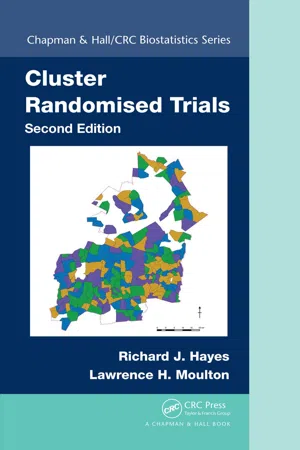![]()
Section III
Analytical Methods
![]()
9
BasicPrinciples of Analysis
9.1 Introduction
This part of the book focuses on the analysis of CRTs. A wide range of analytical methods have been proposed for this purpose, and it is not necessary for the practitioner to have a detailed understanding of all such methods. Rather than providing an encyclopaedic review of available methods, our aim is to provide the reader with a limited number of analytical tools that have proven to be robust and efficient and that cover the main types of CRT study design.
9 is a preliminary chapter that outlines some of the basic principles underlying the analysis of CRTs. After discussing the different types of experimental and observational units in CRTs, we focus on the importance of arriving at a clear definition of the parameters of interest , which are usually alternative measures of intervention effect. As we shall see, a clear formulation of the statistical model is the key to this step. We go on to discuss the two main approaches to analysis, based on cluster-level summaries or individual-level data . Finally, we outline the role of analyses carried out on baseline data.
Chapters 10 and 11 provide more detailed accounts of cluster-level analysis and individual-level analysis of unmatched studies, while Chapter 12 discusses analytical methods for other CRT designs including matched and stratified studies.
9.2 Experimental and Observational Units
As we have seen, the key difference between a CRT and an individually randomised trial is that the intervention is randomly allocated to clusters of individuals rather than to individual subjects. The cluster therefore constitutes the experimental unit in a CRT. Random allocation of clusters to treatment arms aims to ensure that the clusters in each treatment arm are similar as far as possible, although we have seen that this aim may be only partly achieved if the number of clusters is small, as in some CRTs.
Even more importantly, random allocation ensures that any difference that does exist between the treatment arms, apart from the effect of intervention, is due to chance. The extent of this random error can be quantified by using statistical inference based on a model which states that the cluster-level results for each treatment arm come from the same distribution, in the absence of an intervention effect. By quantifying this random error at the cluster level, we are then able to make inferences about the intervention effect. Thus, while there are different approaches to analysis, the underlying principle is that intervention effects are measured by analysing the variation between cluster-level outcomes.
While the cluster is always the experimental unit in a CRT, observations may be made at different levels and there may, therefore, be several different types of observational unit . In the simplest case, observations may be made only on the individual subjects in each cluster. More often, however, data will also be collected on cluster-level variables and, in some CRTs, there may also be intermediate levels of observation.
Example 9.1
Consider a CRT of impregnated bednets for the reduction of child mortality from malaria in which the cluster is a group of neighbouring villages served by a primary health care facility. Observations may be made at several levels:
•Individual: The primary endpoint will be recorded by following up children aged 0– 4 years to record the rate of child mortality. In addition, individual-level data may be collected on possible confounding factors such as age, sex, weight, height and immunisation status.
•Household: Relevant variables at household level might include indicators of socioeconomic status (type of housing, occupation or educational level of household head), ethnic group and measures of treatment-seeking behaviour for common illnesses.
•Village: Distance from health facility might be recorded as a proxy for ease of accessing treatment for malaria. Size of village and adjacency to vector breeding sites might also be important indicators of malaria risk.
•Cluster: Type of health care facility (e.g. hospital, health centre or dispensary) may be relevant.
Example 9.2
In a CRT of a school-based health education programme, in which the intervention is randomly allocated to schools, units of observation might include:
•Individual pupil: For example, age, sex, ethnicity, socioeconomic status of family.
•Class: For example, grade, stream, size, number of students, number of sessions delivered.
•School: For example, urban/rural, type of school, size of school.
Data from all these levels may be used when making inferences about the main parameters of interest.
9.3 Parameters of Interest
An important step in the conduct of any trial is to make a clear statement of the main objectives of the study. In the protocol, these objectives are likely to be presented verbally. Two examples of primary objectives might be
•To measure the effect of a new strategy for treatment of back pain in primary care on the mean pain score reported by patients with lower back pain.
•To determine whether regular mass treatment to eliminate intestinal worm infections in young children has any effect on th...
